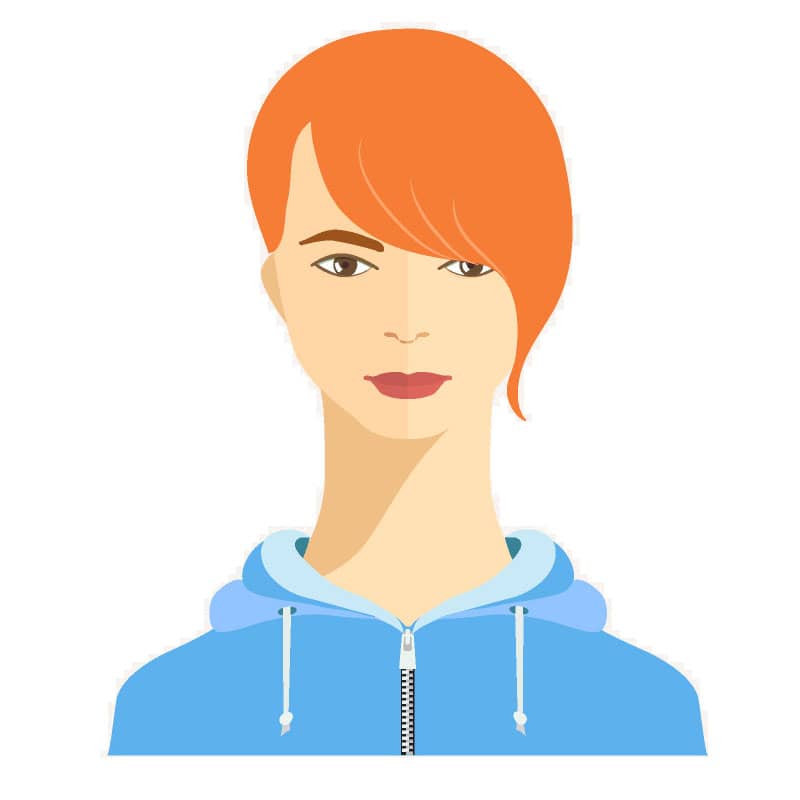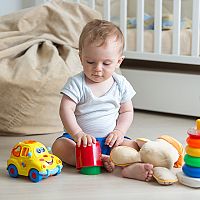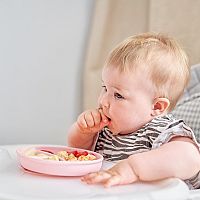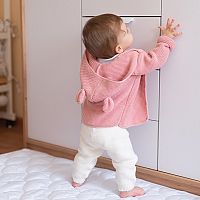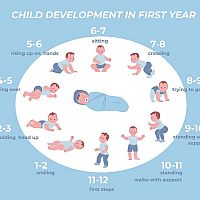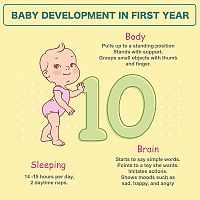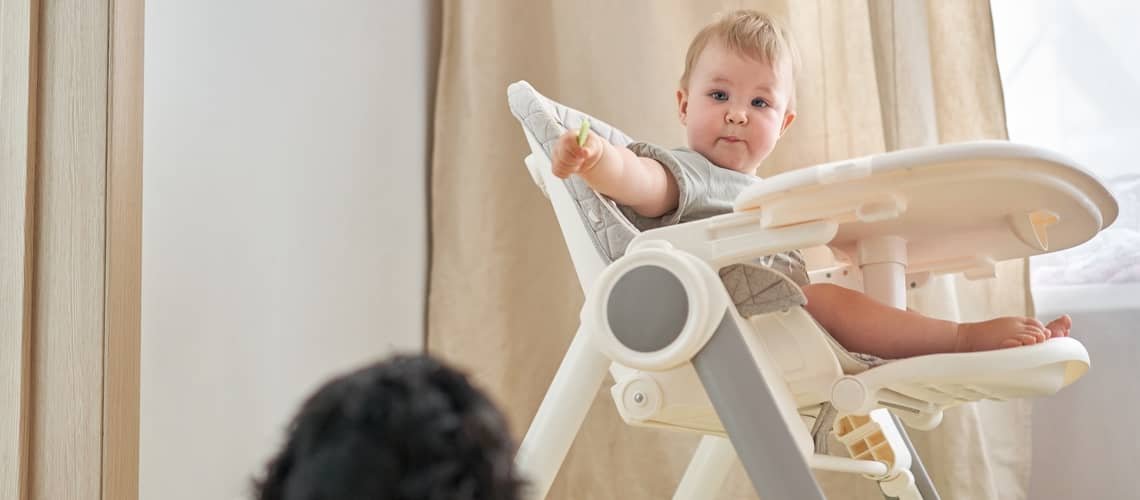
10-month-old baby (child) - development, diet, sleep, exercises, toys. See what it can do
More and more, parents can be surprised by the leaps and bounds in the child's development. It is not for nothing that it is said that a 10-month-old baby gets the nickname "climber". Most children have already mastered coordinated movement on all fours. Others like to crawl. As a rule, the child already knows how to sit up by himself. The movement apparatus is perfected in detail. Passive understanding of "adult speech" also develops, and the first "words" that intentionally name objects, phenomena or persons also appear. The child likes to discover, to search - kitchen drawers, kitchen cabinets or the space under the table are places he needs to get to know. The child understands the negative, although he still interprets it in his own way. He can perceive the first instructions, especially if he can visually see what is expected of him. More foods are being added to the menu, including those that many parents are afraid of.
If the child learned something a month ago and it was new, in the 10th month it will be a level better. The child will improve in everything he knows so far. The parent often doesn't even realize that there are small advances in gross and fine motor skills that mean a gradual process to bigger changes. After all, your child will soon be a year old. Sensory perception also undergoes changes. The child understands the prohibition, still in his own way, but does not yet distinguish between good and bad. He likes recognition and praise, which are motivation for further development. A visit to the pediatrician is also expected in the 10th to 11th month, because the 3rd dose of hexavaccine (mandatory vaccination) is also expected.
What can a 10-month-old baby do?
At this age, children are usually very movement oriented and active. They can crawl, sit up on their own or go on all fours. They also climb the stairs in fours. Parents will get more wrinkles, because the sight of a child climbing on a sofa or chair can cause panic. Descending safely can still be a problem, so caution is in order. Don't worry, even the best parent can't keep eyes on their backs, and sometimes a child can't avoid accidents. The child can stand with support on two legs and gradually takes steps to the sides. It transfers the weight to one and then to the other leg, which is the basis for coordinated movement during walking. This is how he can walk around furniture. At this stage, children should not have shoes yet, so that stepping is not affected by the sole and fixation of the arch.
Sitting up from lying down or kneeling is mostly automated. Fine motor skills progress in that the child already grasps objects with the end of the thumb and forefinger. If you show the child that the cube belongs in the container, he can grab it and consciously release his grip. A very good game is to hide the toys from the child's sight, and he takes the initiative to look for them and take them. A proper praise should follow. He consciously hands you a book and wants you to play with him. It is an old adage that a child learns the most while playing. He can also hold a plastic spoon during feeding. Smarter, or those who progress faster can already hold a plastic mug and drink from it.
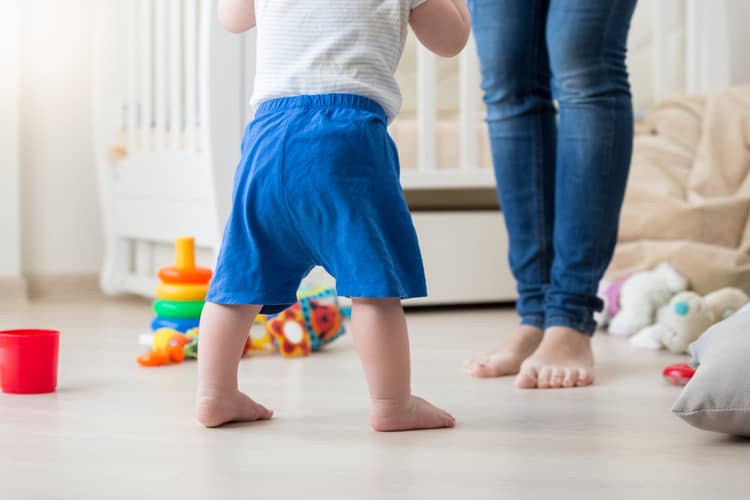
A 10-month-old baby is not four-legged? Is this a problem? It is important to note that not every child develops according to the book. All psychomotor development is very individual and is influenced by several factors, including genetics. In infants, many advances come in leaps and bounds. If a 10-month-old child is not on all fours, he may not be and it is not a problem in principle. Some children skip this stage and start sitting up and standing up a few weeks later. They prefer crawling and moving around furniture. Many parents encountered the fact that in one month the baby was on all fours, sitting and even started to walk.
A 10-month-old baby already wants, but does not understand
The initiative of a 10-month-old child is sometimes exemplary. Another problem is that the child does not understand many meanings. A child does not know physical quantities, does not understand the meaning of most words, and thus acts and makes decisions on his own because he wants to. He begins to understand that he cannot fit the larger cube into the smaller hole. Perceives the purpose of some objects through visual memory. However, he still does not understand the meaning.
Emotions also develop. The child perceives very joyfully if the mother gives him a kiss, the father caresses him, and he looks for several interactions and reacts to them with syllables, laughter and joy. He can repay the actions themselves, for example with a kiss on the cheek. If you read animal books and imitate the sounds, the child will point to the animal with his finger and invite you to imitate the sound with his eyes, and this is exactly what the baby will try to do in time. Sometimes you might catch your little one having a monologue with himself. He tries to imitate the adults whose conversations he listens to. Passive vocabulary is also expanded in this way. A baby can remember the melody of a favorite song, which when he hears it, he laughs and starts to enjoy it.
In addition to crying, 10-month-old children can also express their requests with gestures. They usually point to the food they want, a book, toys, or point to the place where they want to sit. Lying in the crib without some entertainment is rather rare. They also use yelling and screaming to communicate, which can sometimes evoke anger. The first words mama, haf haf, tato or baba are often already in a child's speech. The child can follow your requests, simple instructions, such as close the cabinet, take away the cup, bring the diaper or find dad. He will happily imitate the adults around him, which is a great "school".
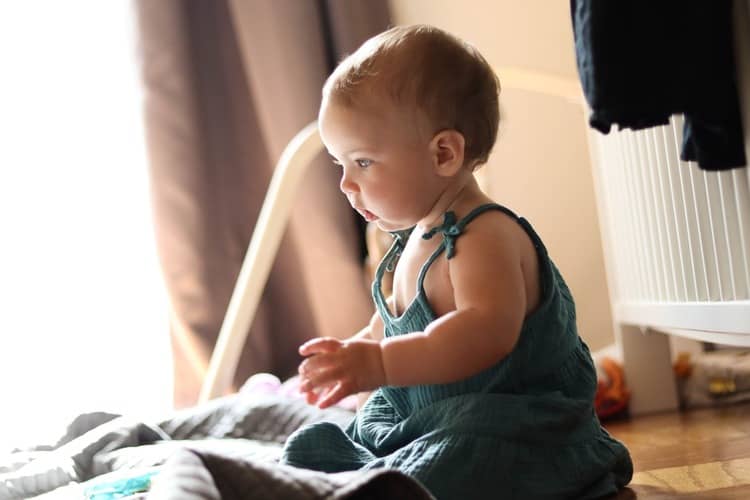
3rd dose of hexavaccine in the 10th-11th month
As part of the vaccination calendar, it is important to be vaccinated with the 3rd dose, mandatory hexavaccine against tetanus, viral hepatitis B, diphtheria, whooping cough, polio and hemophilus invasive infection in the 10th - 11th month. At the same time, he is vaccinated against pneumococcal invasive diseases. It is a vaccination in accordance with the Decree of the Ministry of Health of the Slovak Republic no. 585/2008 Coll. Other basic vaccinations and revaccinations are part of this decree. During your regular routine visit to the pediatrician, your pediatrician will notify you of the vaccination date.
10-month-old child - diet and menu
The diet is getting closer to the family diet. The child should already have a few milk teeth out, so solid food and its consumption should not be impossible for the child. The food base is gradually expanding, and it is better to put aside exaggerated concerns about allergens, because every single food in its essence represents an allergen. It is recommended to avoid smoked meats, sweets, processed cheese, mold cheese, radish, garlic, onion and several spices. If a 10-month-old child does not want to eat, the reason can often be inappropriate food, which the child is not yet used to.
Do not continue to add salt or flavor to side dishes. The most suitable are still fruits (banana, blueberries, apple, mango, avocado), vegetables (potatoes, sweet potatoes, beets, zucchini, pumpkin, carrots, spinach), legumes or cereal porridges (barley groats, buckwheat porridge, millet, couscous). From dairy products, white yogurts or unflavored sour cream. Appetizers should also consist of a meat component - chicken, turkey or rabbit are the best choice. It is no longer necessary to mix the ingredients completely. Sometimes, however, the child may go on strike and will refuse even the food that he used to eat in solid food. Rejection may be related to the cutting of milk teeth. In that case, bet on more liquid and mushy foods. If the baby is breastfed, try to increase the intake of breast milk and fluids.
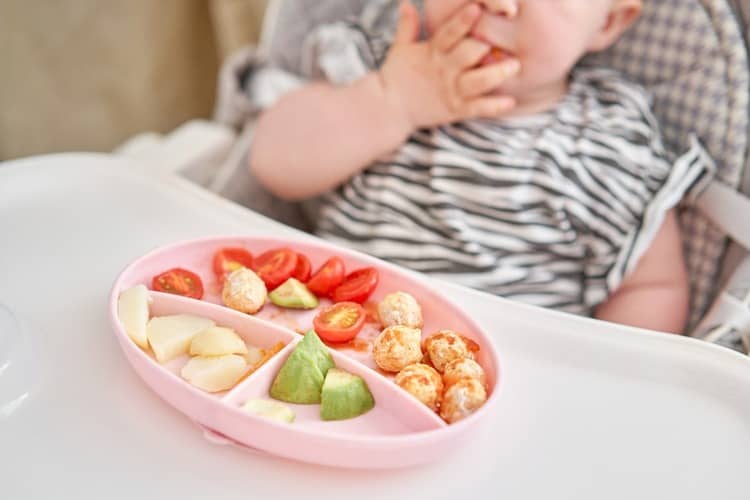
Sleep and games for a 10-month-old baby
Children enjoy movement games, nursery rhymes, picture books, interactive audio books. The child can already turn the pages by himself. He really enjoys hiding toys. Toy boxes or chests are very interesting for children, where you can place them and the child will explore. This also applies to drawers, cupboards or the kitchen counter, where the child will be happy to discover kitchen utensils. Watch out for you. The child likes to clean, but expect that without a system.
Play yes and no with him, teach him to nod his head for yes and no. In this way, you can instill in him a sense of understanding. If you pick up a toy, nod your head yes and give it to him, grab the phone, nod no and create a negative signal. After small steps, the child will understand the difference. A sleep ritual is important, during the day the child indulges in 2 shorter sleep cycles. Falling asleep at night should always have the same course and should be preceded by the same activities. Do not unnecessarily stimulate the child with play. If a 10-month-old doesn't want to sleep, try a book, toys, or pretend you're going to sleep with him. Sometimes falling asleep can be complicated by gum pain.
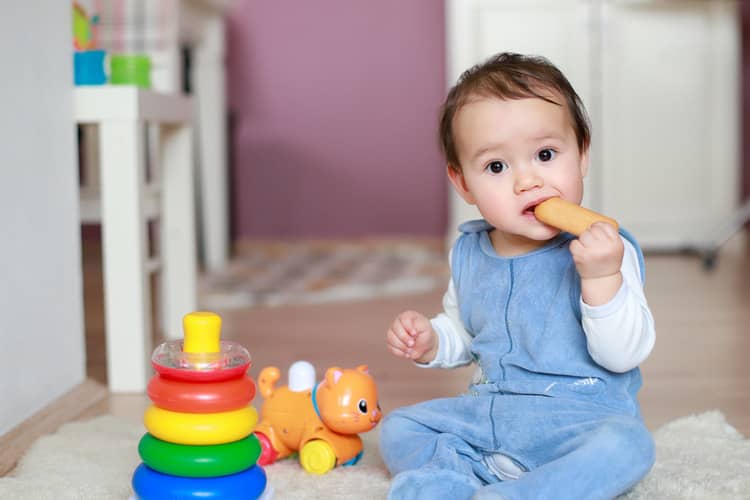
The most frequent questions - FAQ
The perception of a 10-month-old child is at a very high level. A 10-month-old child already wants to understand a lot, although it is not yet completely successful, it is the effort that is the basis for developing his senses and understanding. His whole surroundings are a big playground for him and he usually enjoys all stimuli after four. The child surprises, syllabifies, repeats after adults and even manages to understand the first instructions. Visual memory works a little better and the child notices the space around him. What progress has your child made in 10 months? Have you been trying to figure out why your 10-month-old keeps crying or wakes up a lot? Your experience can be very helpful. Under the article, you can join the discussion and give advice to other mothers.
Is it a problem if a 10-month-old child is not crawling?
A 10-month-old child refuses the breast, what to do about it?
What if a 10-month-old child is not on all fours?
What is the weight of a 10-month-old baby?
Gallery
Pridať komentár
